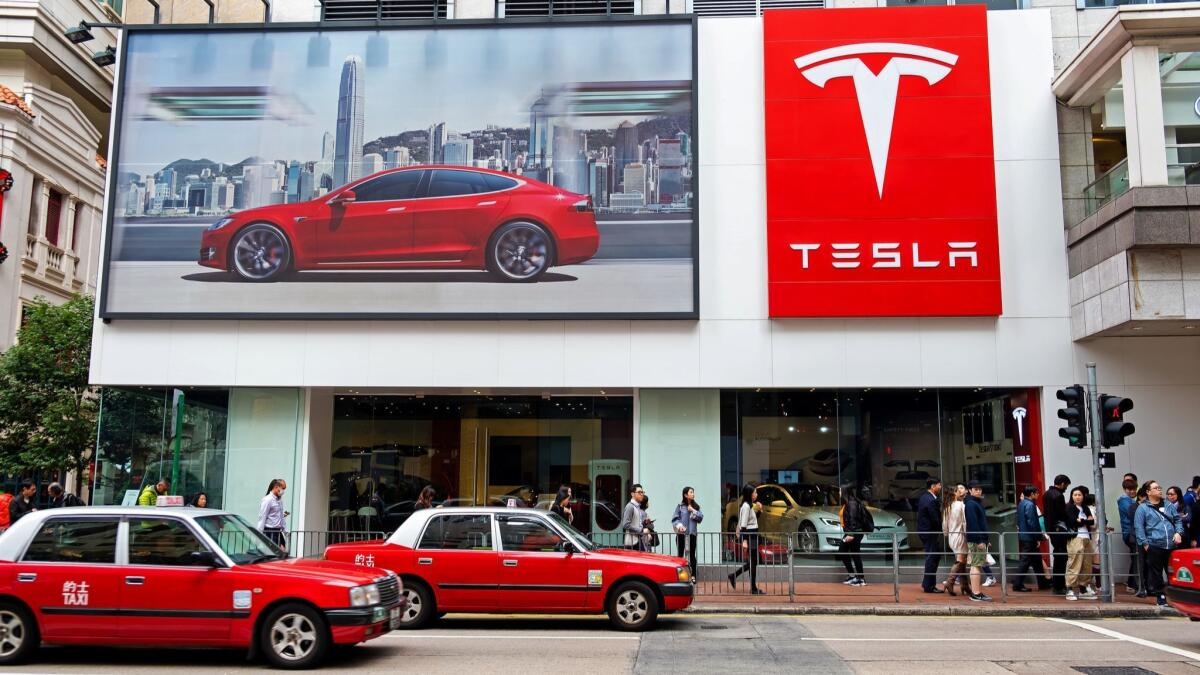Elon Musk reopens the possibility Tesla will need to raise more cash

Elon Musk’s declarations that Tesla Inc. was done losing money and needing to raise more cash turned out to be premature.
The chief executive is reopening the door to seeking capital for the maker of the electric Model 3 sedan after posting a bigger-than-expected first-quarter loss. A record drop in deliveries, combined with the company’s largest-ever debt payment, depleted cash to the lowest level in three years.
The showing led a Wedbush analyst to back away from his positive assessment of the electric automaker’s prospects. Daniel Ives called Tesla’s quarter “one of top debacles” he has seen in 20 years of covering tech stocks.
Ives said that Tesla’s guidance was aggressive and that its management was not doing enough to cut costs, preserve capital and provide a sustained path to profitability. He downgraded the stock to the equivalent of a “hold” from “buy,” and slashed his price target to $275 from $365.
Tesla shares fell 4% on Thursday to $247.63, close to its 52-week low of $246.07.
Musk, 47, assured investors that higher deliveries and cost cuts will help Tesla post a narrower loss for this quarter and return to profitability next quarter. But he also went a step further than his hint this week that Tesla may seek more funds as he embarks on a hugely ambitious pursuit to unleash fully autonomous robotaxis in a shared service next year.
Elon Musk claims a million Teslas will drive themselves in a year. Safety advocates have concerns »
“There is merit to the idea of raising capital at this point,” Musk said on an earnings call Wednesday. “It is very important as the company scales to make sure we are on a solid foundation and that we have the appropriate financial discipline across the company and that we are spending money very efficiently. At this point, I think we are doing that.”
Ives wasn’t impressed. “Musk & Co. in an episode out of the ‘The Twilight Zone’ act as if demand and profitability will magically return to the Tesla story,” Ives said.
Tesla reported an adjusted first-quarter loss of $494 million, or $2.90 a share. On average, analysts had expected a loss of only $1.30 per share.
The company is planning as much as $2.5 billion in capital expenditures this year as it develops new vehicles including the Model Y crossover and Semi truck. That’s more than the $2.2 billion in cash and equivalents that were on the balance sheet at the end of March.
“Two-point-two billion dollars in cash is a lot of money, but not when you’re making the kinds of investments Tesla is making,” Rebecca Lindland, a longtime auto-industry analyst and founder of the car-review website RebeccaDrives.com, said on Bloomberg Television. “I’m definitely concerned about some of their projections.”
In addition to operating cash flow worsening relative to the previous quarter, a February debt payment — the company’s largest ever — drained $920 million from its coffers. The company has an additional $566 million of convertible bonds coming due in November.
The halving of a federal tax incentive for Tesla purchases starting in January dragged on U.S. demand in the quarter, and Tesla struggled to offset that drop by starting deliveries of the Model 3 in Europe and China.
Also putting a damper on results were frequent price changes and a botched retail strategy shift that stoked confusion among employees and customers. Musk announced on Feb. 28 that, in order to offer a long-promised $35,000 version of the Model 3, Tesla was shifting all ordering online and closing most of its showrooms. The company backtracked 10 days later, saying it would shut only about half as many locations as planned.
“We will certainly continue to have stores and we will continue to add stores, provided they are in locations where there is high foot traffic,” Musk said Wednesday. “But we will close stores in locations where they’re incredibly hard to find where foot traffic of potential buyers is very low.”
Tesla finished the quarter with $768 million in customer deposits, down from $793 million at the end of last year, despite the unveiling of the Model Y in March. When asked about the state of orders for the vehicle the company expects to produce next year, Musk declined to comment on the “granularity of deposits.”
During Musk’s deep dive Monday into the technology behind Tesla’s semiautonomous Autopilot system and its plans for a fully autonomous robotaxi, the CEO reset expectations for future cash flow. Whereas the company had said in the past that it expected to be positive in every quarter beyond the first three months of this year, Musk said the goal is now to be “neutral” while Tesla builds up a fleet of self-driving vehicles.
When asked by an analyst Monday how much the autonomous endeavor is costing Tesla, Musk replied: “It’s basically our entire expense structure.”
On Wednesday, Tesla reaffirmed a forecast that it will deliver 360,000 to 400,000 cars in 2019. The company delivered about 63,000 vehicles in the first quarter, so on average it’ll need to hand over roughly 100,000 cars to customers in each of the next three quarters to reach the low end of its guidance.
Musk’s comments on Tesla’s cash position were a far cry from a year ago, when he interrupted an analyst who told him many investors were in favor of the company raising capital when it didn’t need to.
“I disagree,” Musk said in May 2018. When asked whether he might want to raise cash, he replied: “No. I specifically don’t want to.”






